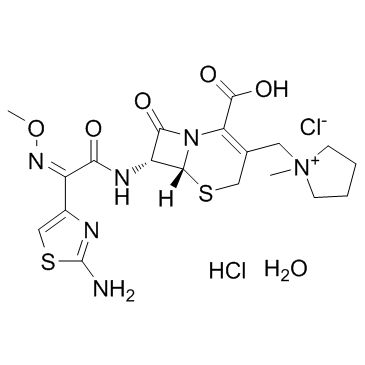Cefepime Dihydrochloride Monohydrate

Cefepime Dihydrochloride Monohydrate structure
|
Common Name | Cefepime Dihydrochloride Monohydrate | ||
|---|---|---|---|---|
| CAS Number | 123171-59-5 | Molecular Weight | 571.498 | |
| Density | N/A | Boiling Point | N/A | |
| Molecular Formula | C19H28Cl2N6O6S2 | Melting Point | 150ºC(dec.) | |
| MSDS | N/A | Flash Point | N/A | |
Use of Cefepime Dihydrochloride MonohydrateCefepime Dihydrochloride Monohydrate is a broad-spectrum cephalosporin with enhanced coverage against Gram-positive and Gram-negative bacteria.Target: AntibacterialCefepime is an extended-spectrum parenteral cephalosporin antibiotic active in vitro against a broad spectrum of gram-positive and gram-negative aerobic bacteria. Cefepime dosing was 1-4 g/day (0.5-2.0 g twice daily) for adults; ceftazidime dosing was 1-6 g/day (0.5 g every 12 hours to 2.0 g every 8 hours). A limited number of cefepime-treated patients received 2 g every 8 hours. The median length of dosing for both cefepime and ceftazidime was 7 days [1]. Cefepime has a decreased propensity to induce beta-lactamases compared with other beta-lactam antibiotics. Cefepime has a pharmacokinetic disposition similar to that of other renally eliminated cephalosporins, with a half-life of approximately 2 hours. Cefepime has demonstrated clinical efficacy against a variety of infections, including urinary tract infections, pneumonia, and skin and skin structure infections. Cefepime is generally well tolerated [2]. |
| Name | cefepime hydrochloride |
|---|---|
| Synonym | More Synonyms |
| Description | Cefepime Dihydrochloride Monohydrate is a broad-spectrum cephalosporin with enhanced coverage against Gram-positive and Gram-negative bacteria.Target: AntibacterialCefepime is an extended-spectrum parenteral cephalosporin antibiotic active in vitro against a broad spectrum of gram-positive and gram-negative aerobic bacteria. Cefepime dosing was 1-4 g/day (0.5-2.0 g twice daily) for adults; ceftazidime dosing was 1-6 g/day (0.5 g every 12 hours to 2.0 g every 8 hours). A limited number of cefepime-treated patients received 2 g every 8 hours. The median length of dosing for both cefepime and ceftazidime was 7 days [1]. Cefepime has a decreased propensity to induce beta-lactamases compared with other beta-lactam antibiotics. Cefepime has a pharmacokinetic disposition similar to that of other renally eliminated cephalosporins, with a half-life of approximately 2 hours. Cefepime has demonstrated clinical efficacy against a variety of infections, including urinary tract infections, pneumonia, and skin and skin structure infections. Cefepime is generally well tolerated [2]. |
|---|---|
| Related Catalog | |
| References |
| Melting Point | 150ºC(dec.) |
|---|---|
| Molecular Formula | C19H28Cl2N6O6S2 |
| Molecular Weight | 571.498 |
| Exact Mass | 570.088867 |
| PSA | 212.81000 |
| LogP | 1.12860 |
| Storage condition | Store at 0-5°C |
| Hazard Codes | Xi |
|---|---|
| Risk Phrases | R36/37/38 |
| Safety Phrases | 22-26-36/37/39 |
| RIDADR | NONH for all modes of transport |
| HS Code | 29419000 |
|
A degradation study of cefepime hydrochloride in solutions under various stress conditions by TLC-densitometry.
Biomed. Chromatogr. 29(3) , 388-95, (2015) A rapid, accurate and sensitive thin-layer chromatography (TLC) method with densitometric detection has been developed and validated for the determination of cefepime in pharmaceuticals. Chromatograph... |
|
|
In vitro and in vivo antibacterial activity of Pogostone.
Chin. Med. J. 127(23) , 4001-5, (2014) Our pervious antibacterial studies on several traditional Chinese medicines have found that Patchouli oil from Pogostemon cablin had significant antibacterial activity against methicillin-resistant St... |
| cefepime dihydrochloride monohydrate |
| Cefepime hydrochloride |
| Pyrrolidinium, 1-[[(6R,7R)-7-[[(2Z)-2-(2-amino-4-thiazolyl)-2-(methoxyimino)-1-oxoethyl]amino]-2-carboxy-8-oxo-5-thia-1-azabicyclo[4.2.0]oct-2-en-3-yl]methyl]-1-methyl-, chloride, hydrochloride, hydrate (1:1:1:1) |
| MFCD06804606 |
| Axepim |
| 1-{[(6R,7R)-7-{[(2Z)-2-(2-Amino-1,3-thiazol-4-yl)-2-(methoxyimino)acetyl]amino}-2-carboxy-8-oxo-5-thia-1-azabicyclo[4.2.0]oct-2-en-3-yl]methyl}-1-methylpyrrolidinium chloride hydrochloride hydrate (1:1:1:1) |
| pyrrolidinium, 1-[[(6R,7R)-7-[[(2Z)-2-(2-amino-4-thiazolyl)-2-(methoxyimino)-1-oxoethyl]amino]-2-carboxy-8-oxo-5-thia-1-azabicyclo[4.2.0]oct-2-en-3-yl]methyl]-1-methyl-, inner salt, hydrochloride, hydrate (1:2:1) |
| (6R-(6a,7b(Z)))-1-((7-(((2-Amino-4-thiazolyl)(methoxyimino)acetyl)amino)-2-carboxy-8-oxo-5-thia-1-azabicyclo[4.2.0]oct-2-en-3-yl)methyl)-1-methylpyrrolidinium Chloride Monohydrochloride Monohydrate |
| 1-(((6R,7R)-7-(2-(2-Amino-4-thiazolyl)glyoxylamido)-2-carboxy-8-oxo-5-thia-1-azabicyclo[4.2.0]oct-2-en-3-yl)methyl)-1-methylpyrrolidinium Chloride 72-(Z)-(O-Methyloxime) Monohydrochloride Monohydrate |
| (6R,7R)-7-{[(2Z)-2-(2-amino-1,3-thiazol-4-yl)-2-(methoxyimino)acetyl]amino}-3-[(1-methylpyrrolidinium-1-yl)methyl]-8-oxo-5-thia-1-azabicyclo[4.2.0]oct-2-ene-2-carboxylate dihydrochloride hydrate |
| Cefepime chloride hydrochloride hydrate |
| Cefepime (Dihydrochloride Monohydrate) |

